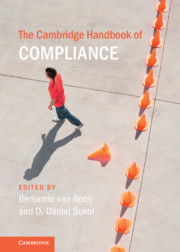Book contents
- The Cambridge Handbook of Compliance
- The Cambridge Handbook of Compliance
- Copyright page
- Contents
- Figures
- Tables
- Contributors
- 1 Introduction: Compliance as the Interaction between Rules and Behavior
- Part I Compliance Concepts and Approaches
- Part II Deterrence and Incapacitation
- Part III Incentives
- Part IV Legitimacy and Social Norms
- 27 Procedural Justice and Legal Compliance
- 28 Social Norms and Persuasion
- 29 Social Contagion and Goal Framing: The Sustainability of Rule Compliance
- 30 Shaming and Compliance
- 31 Neutralization
- Part V Capacity and Opportunity
- Part VI Compliance and Cognition
- Part VII Management and Organizational Processes
- Part VIII Measuring and Evaluating Compliance
- Part IX Analysis of Particular Fields
- References
29 - Social Contagion and Goal Framing: The Sustainability of Rule Compliance
from Part IV - Legitimacy and Social Norms
Published online by Cambridge University Press: 07 May 2021
- The Cambridge Handbook of Compliance
- The Cambridge Handbook of Compliance
- Copyright page
- Contents
- Figures
- Tables
- Contributors
- 1 Introduction: Compliance as the Interaction between Rules and Behavior
- Part I Compliance Concepts and Approaches
- Part II Deterrence and Incapacitation
- Part III Incentives
- Part IV Legitimacy and Social Norms
- 27 Procedural Justice and Legal Compliance
- 28 Social Norms and Persuasion
- 29 Social Contagion and Goal Framing: The Sustainability of Rule Compliance
- 30 Shaming and Compliance
- 31 Neutralization
- Part V Capacity and Opportunity
- Part VI Compliance and Cognition
- Part VII Management and Organizational Processes
- Part VIII Measuring and Evaluating Compliance
- Part IX Analysis of Particular Fields
- References
Summary
Abstract: Rule compliance (in organizations or society at large) may be strengthened or weakened by social contagion processes. Observing others’ (non-)compliance with rules influences one’s own likelihood of compliance. Extant literature shows two social contagion theories that can explain this phenomenon. First, the theory of normative conduct (TNC) (Cialdini et al. 1990) suggests that people interpret the observed behaviour of others (i.e. the descriptive norm) as adaptive for that context, resulting in rational imitation. Second, Goal Framing Theory (GFT) (Lindenberg and Steg 2007) suggests that we should look not just at the contagion of concrete behaviour but at the process that governs the contagion of the very goal to comply with norms and legitimate rules. This is particularly important because it predicts that observed (non-)compliance regarding one rule also affects (non-)compliance with other rules (‘cross-norm effects’). Because the goal to comply tends to decay, it needs continuous support from the observation of other people’s respect for norms and legitimate rules. Compliance and non-compliance are thus both self-reinforcing mechanisms. This has clear implications for policy which are discussed in this chapter, most notably the importance of a focus on legitimizing rules, so that they are interpreted as norms by the general public.
- Type
- Chapter
- Information
- The Cambridge Handbook of Compliance , pp. 422 - 437Publisher: Cambridge University PressPrint publication year: 2021
References
- 5
- Cited by

